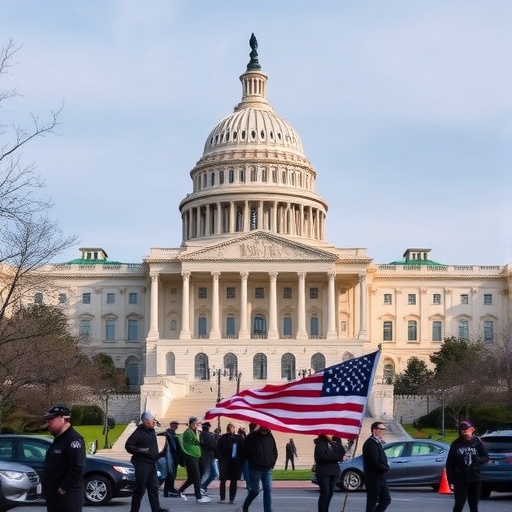U.S. Government Shutdown Persists as Second-Longest in History: Trump’s Control Push Clashes with Democratic Resolve
As the clock ticks past 35 days, the U.S. Government Shutdown has cemented its place as the second-longest in American history, leaving federal workers unpaid and essential services in limbo while President Trump wields the crisis to tighten his grip on government operations. This escalating standoff, rooted in battles over border funding, shows no signs of abating, with Democrats vowing to make Republicans pay at the polls for the mounting chaos.
- Trump’s Shutdown Gambit: Asserting Executive Dominance Over Funding Fights
- Democrats Hold Firm: Shutdown Blame Game Targets Republican Leadership
- Economic Ripples Widen: From Federal Paychecks to Global Market Jitters
- Historical Shadows: Lessons from Past Shutdowns Fuel Current Tensions
- Stalemate’s Shadow: What Breaking the Shutdown Impasse Might Entail
Trump’s Shutdown Gambit: Asserting Executive Dominance Over Funding Fights
President Trump has framed the ongoing Government Shutdown as a necessary stand for national security, particularly emphasizing his demand for $5.7 billion in wall funding along the southern border. In a recent address from the White House, Trump declared, “This is about protecting our country, and I’m not backing down.” Sources close to the administration reveal that the shutdown serves a dual purpose: not only to pressure Congress on immigration but also to streamline federal bureaucracy under executive oversight. By withholding appropriations, the administration has paused non-essential operations across agencies like the Department of Housing and Urban Development and the Internal Revenue Service, allowing Trump to redirect resources toward priorities such as immigration enforcement.
This strategy echoes Trump’s broader vision of reshaping government, as outlined in his executive orders aimed at reducing regulatory burdens. Critics, however, argue it’s a power play. A report from the Government Accountability Office (GAO) estimates that the shutdown has already cost the economy $11 billion, with long-term effects potentially reaching $18 billion if it extends further. Federal employees, from air traffic controllers to national park rangers, are bearing the brunt, many working without pay for the first time since the 2013 shutdown. One TSA officer at Reagan National Airport shared anonymously, “We’re showing up every day, but the uncertainty is killing us. Families are dipping into savings just to make rent.”
The Trump administration’s approach has drawn sharp rebukes from economists. The Congressional Budget Office warns that prolonged disruption could shave 0.2 percentage points off GDP growth in the first quarter of 2019. Yet, White House advisors insist the tactic is yielding results, pointing to increased deportations by ICE during the lull in oversight. As the shutdown drags on, Trump’s insistence on linking disaster relief and farm aid to border wall funding has only hardened lines, turning what began as a December 22 impasse into a full-blown constitutional crisis.
Democrats Hold Firm: Shutdown Blame Game Targets Republican Leadership
House Speaker Nancy Pelosi and Senate Minority Leader Chuck Schumer have led the Democrats in a unified front, rejecting any compromise that funds Trump’s border wall without comprehensive immigration reform. “The American people didn’t vote for a shutdown; they voted for solutions,” Pelosi stated during a press conference on Capitol Hill. Democrats passed multiple funding bills in the House—over a dozen since the shutdown began—only to see them stall in the Republican-controlled Senate. Their argument is clear: voters will remember who shuttered the government when midterm gains translate to 2020 accountability.
Polling data supports their stance. A recent Quinnipiac University survey found that 53% of Americans blame Trump and Republicans for the Government Shutdown, compared to just 29% pointing fingers at Democrats. This public sentiment has emboldened the party, with figures like Sen. Elizabeth Warren calling the shutdown “a manufactured crisis by a president desperate for his vanity project.” Democratic leaders have highlighted the human cost, from furloughed Smithsonian workers to delayed FDA inspections that could impact food safety nationwide.
In a strategic move, Democrats have tied the shutdown to broader issues like healthcare and infrastructure. Rep. Alexandria Ocasio-Cortez tweeted, “While we’re fighting for paychecks, Trump’s using this to gut protections for working families.” The party’s resistance isn’t without internal debate; moderate Democrats from border states worry about the political fallout, but the caucus remains cohesive, leveraging their House majority to force Senate votes and public hearings. As one senior Democratic aide noted, “We’re playing the long game—let the impacts sink in, and the voters will deliver the verdict.”
Economic Ripples Widen: From Federal Paychecks to Global Market Jitters
The Government Shutdown‘s tentacles reach far beyond Washington, inflicting tangible pain on everyday Americans and sending shockwaves through global markets. Over 800,000 federal employees are either furloughed or working without pay, a figure that doesn’t include the ripple effects on contractors and private sector jobs. The National Park Service alone reports a loss of $80 million in visitor spending since the shutdown began, with iconic sites like Yosemite facing vandalism and maintenance backlogs due to skeleton crews.
Statistics paint a grim picture: the U.S. Travel Association estimates tourism losses at $200 million per day, while small businesses near federal installations report a 20-30% drop in revenue. In Alaska, Coast Guard families are struggling without timely pay, prompting Gov. Bill Walker to declare a state of emergency. “These are our heroes on the front lines, and now they’re the ones needing rescue,” Walker said. Food stamp programs, affecting 40 million low-income Americans, face delays in processing, with the USDA warning of potential SNAP benefit disruptions by late February if unresolved.
Internationally, the shutdown has eroded U.S. credibility. Trade negotiations with China have stalled, and allies like the EU express concern over delayed military reimbursements. Wall Street has reacted with volatility; the Dow Jones dipped 1.2% in the week following Christmas amid fears of prolonged uncertainty. Economists at Moody’s Analytics project that every additional week adds $1.5 billion in losses, disproportionately hitting blue-collar communities in states like Virginia and Maryland, where federal jobs dominate the economy.
- Federal Worker Impacts: 380,000 essential workers unpaid but on duty; 420,000 furloughed.
- Agency Disruptions: IRS tax refunds delayed, affecting 11 million early filers; NIH clinical trials paused, endangering patient care.
- Long-Term Risks: Credit rating agencies like S&P warn of potential U.S. debt ceiling complications if shutdown overlaps with March deadlines.
Personal stories underscore the crisis: A Smithsonian curator in D.C. told reporters she’s maxing out credit cards to cover her daughter’s college tuition, while a furloughed NASA engineer in Houston worries about mortgage payments. These narratives fuel bipartisan calls for action, yet partisan entrenchment persists.
Historical Shadows: Lessons from Past Shutdowns Fuel Current Tensions
This Government Shutdown isn’t the first, but its duration—now eclipsing the 21-day 1995-1996 impasse under President Clinton—marks a troubling escalation. The record-holder remains the 1995-1996 shutdowns, totaling 35 days across two episodes, driven by disputes over spending cuts. Back then, public approval for Gingrich’s Republicans plummeted, paving the way for Clinton’s reelection. Historians draw parallels: today’s crisis, like its predecessors, stems from budget brinkmanship, but amplified by social media and polarized media landscapes.
Under Trump, the shutdown’s third since he took office, the stakes feel higher. The 2018-2019 episode began over DACA protections but pivoted to wall funding, a signature Trump promise. Unlike previous shutdowns, this one coincides with investigations into the administration, including Mueller’s probe, adding layers of political intrigue. A study by the Pew Research Center notes that shutdowns have become more frequent since 2010, correlating with rising partisanship; today’s divide sees approval ratings for Congress at historic lows of 18%.
Lessons from history abound. The 2013 shutdown, lasting 16 days over Obamacare funding, cost $24 billion and unified Democrats while fracturing GOP unity. Speaker John Boehner later reflected, “It was a loser for us—never again.” Yet, here we are, with Senate Majority Leader Mitch McConnell blocking House bills, mirroring past tactics. Experts like Norman Ornstein of the American Enterprise Institute warn, “This could redefine governance, turning shutdowns into routine weapons rather than anomalies.” As the Government Shutdown stretches, it risks normalizing dysfunction, eroding trust in institutions that Americans rely on.
Stalemate’s Shadow: What Breaking the Shutdown Impasse Might Entail
Looking ahead, resolving the Government Shutdown hinges on concessions neither side seems willing to make, but pressure is mounting from all quarters. Trump has hinted at declaring a national emergency to bypass Congress for wall funding, a move that could trigger legal battles and further alienate moderates in his party. Democrats, eyeing 2020 primaries, are pushing for a clean continuing resolution, potentially tying it to investigations into Trump’s taxes and emoluments.
Potential off-ramps include a bipartisan commission on immigration, as floated by Sen. Lindsey Graham, or phased funding releases monitored by GAO. However, with the debt ceiling looming in March and tax season underway, urgency is building. The U.S. Chamber of Commerce has urged immediate action, estimating 130,000 private sector jobs at risk. Public protests, from D.C. rallies to viral social media campaigns like #EndTheShutdown, are amplifying calls for compromise.
If unresolved, experts predict spillover into the 2020 elections, with Democrats framing it as Republican extremism and Trump portraying Democrats as weak on security. As one Capitol Hill veteran put it, “This isn’t just about a wall—it’s about who controls the narrative of America’s future.” The path forward remains foggy, but the human and economic toll ensures this Government Shutdown will leave lasting scars, demanding accountability from Trump, Democrats, and the fractured Congress alike.








